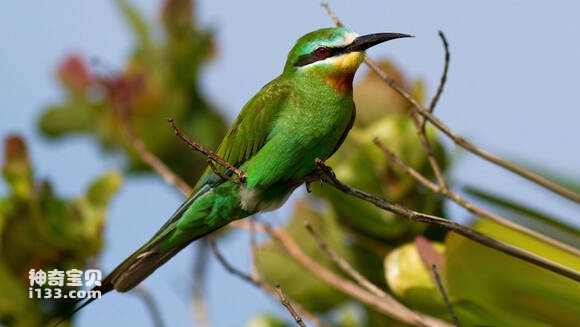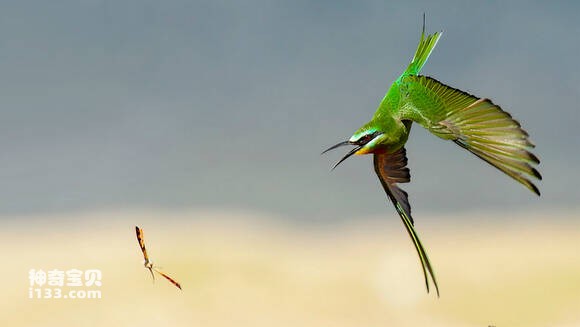Merops persicus
IUCN
LCBasic Information
Scientific classification
- name:Merops persicus
- Scientific Name:Merops persicus,Blue-cheeked Bee-eater,Guêpier de Perse,القارية زرقاء الخدين
- Outline:Climbing birds
- Family:order family genus
Vital signs
- length:27-33cm
- Weight:38-50g
- lifetime:No verification information
Feature
The flying posture is graceful, like a swallow
Distribution and Habitat
Resident birds: Afghanistan, Algeria, Angola, Armenia, Azerbaijan, Bahrain, Benin, Botswana, Burkina Faso, Burundi, Cameroon, Central African Republic, Chad, Congo, Democratic Republic of the Congo, Côte d'Ivoire, Cyprus, Djibouti, Egypt, Eritrea, Ethiopia, Gabon, Gambia, Ghana, Greece, Guinea, Guinea-Bissau, India, Islamic Republic of Iran, Iraq, Israel, Jordan, Kazakhstan, Kenya, Kuwait, Kyrgyzstan, Lebanon, Liberia, Libya , Malawi, Mali, Mauritania, Morocco, Mozambique, Namibia, Niger, Nigeria, Oman, Pakistan, Palestine, Qatar, Russian Federation, Rwanda, Saudi Arabia, Senegal, Seychelles, Sierra Leone, Somalia, South Africa, South Sudan, Sudan, Swaziland, Syrian Arab Republic, Tajikistan, United Republic of Tanzania, Togo, Tunisia, Turkey, Turkmenistan, Uganda, United Arab Emirates, Uzbekistan, Yemen, Zambia, Zimbabwe.
Wandering: Bulgaria, Cape Verde, Comoros, Croatia, Denmark, Finland, France, Gibraltar, Italy, Malta, Montenegro, Netherlands, Serbia, Spain, Sweden, United
Appearance
The blue-cheeked bee-eater has a body length of 27-33 cm, a wingspan of 46-49 cm, and a weight of 38-50 grams. The central tail feathers are very extended and narrow, and the length beyond the side tail feathers is much more than twice the length of the tarsometatarsus; the tail and waist are blue; the throat is maroon and light in color. The front and back of the eyes and the ear coverts are black; the underside and a narrow eyebrow line are light blue-green; from the forehead to the back and the surface of the wings are bright green; the cheeks are bluish-green; the waist and upper tail coverts, and the surface of the tail feathers are copper-green; The ends of the central tail feathers are almost black, and the inner edges of the side tail feathers are light reddish maroon; the primary and secondary flight feathers have light black tips, and the exposed parts of the outermost ones and the innermost ones are light green; the underside of the wings Orange-brown. The chin is bright yel
Details
Blue-cheeked Bee-eater, also known as Blue-cheeked Bee-eater, has two subspecies.

At dusk or after the rain, large groups of blue-cheeked bee-eaters will fly in the air to chase flying insects, especially when there are breeding termites flying around. The sound of the upper and lower jaws beating can be heard frequently; they also live on bare branches and wires, waiting for an opportunity to catch flying insects. They fly gracefully, like a swallow. The sound is pleasant, like a whistle with a tremor, like "triirp", and it often sings while flying.

The breeding season of the blue-cheeked bee-eater is from April to July. They usually nest on the rock slopes beside the forest road or on the cliffs on the river bank, digging holes for nests. During the breeding season, they fly over these environments or on big trees to hunt or roost. There are often multiple pairs of birds in the same community to make nests, and the nests are dug on the vertical river bank or sandy cliffs on the hillside. A horizontal tunnel with a diameter of about 30-40 mm and a depth of about 0.5-2 meters is dug on the sandy soil wall of the forest edge hillside gully or roadside. After years of use, multiple nest holes are often scattered on one wall. The egg chamber is generally without bedding. Each nest lays 4-7 eggs, which are white and oval or round in shape. The male and female birds take turns to build nests, incubate eggs and raise chicks. The chicks are late-maturing.

It is understood that the blue-cheeked bee-eater was originally mainly distributed in the Sahara Desert, Morocco and other places. In June 2014, Li Weidong, a researcher at the Xinjiang Institute of Environmental Protection Sciences, discovered this bird for the first time in the Altun Mountain Nature Reserve, setting a new record for domestic birds. But only one was found at the time, and experts speculated that the blue-cheeked bee-eater might be a lost bird. The bird has not been recorded since it was first discovered in the Altun Mountains in 2014. This discovery can determine that there is a breeding ground for blue-cheeked bee-eaters in Huocheng County, Yili, which is also the first time that a breeding ground for blue-cheeked bee-eaters has been discovered in China.

Listed in the "Red List of Endangered Species of the World Conservation Union" (IUCN) 2016 ver 3.1-Least Concern (LC).
Listed in the second level of China's "National Key Protected Wildlife List" (February 5, 2021).
Protect wildlife and eliminate game.
Maintaining ecological balance is everyone's responsibility!








